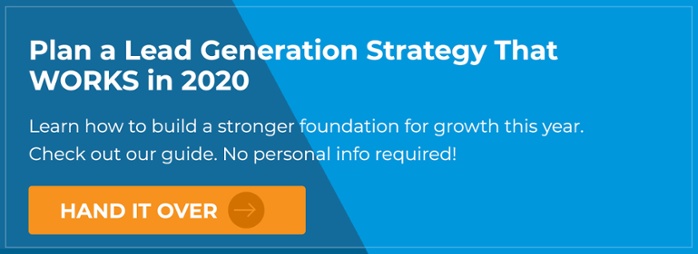
Activate Your Email Marketing Leads With Real Personalization
Patrick Dodge
Founder
Every brand is trying to personalize their marketing emails, but are they doing it in a way that matters to people?
I can speculate on this a little. Most emails I get are hardly personalized at all, at least beyond auto-inserting my first name and company name in the body text.
When I noticed this, I started looking at the emails we were sending to our own contacts and those of our clients, and I didn’t see much of a difference.
Yikes!
I started thinking…what exactly is personalization in marketing anyway?
We have all these amazing tools to collect information about the people visiting our website, and yet we were doing so little with it. So, I tried experimenting with email, personalizing the language based on a number of factors, and discovered a few things that make a big difference.
Segment Your Subscribers Into Smaller Groups.

The words “email blast” make me cringe like few others in this world.
Sending the same email to an entire list of subscribers is just not a good idea anymore -- not if you know more about them than just their email address.
Email blasts were forgivable years ago, before we had automation tools to help us learn about the individuals visiting our websites and downloading our content.
Today, there are a ton of ways to access and organize these insights in your CRM. Blasting your entire list with the same email not only depresses open and click rates, and it can also increase the number of unsubscribes as well.
I’m not saying the message you want to send isn’t relevant to everyone in your database. If your company specializes in Office 365 migrations, an email about a major new update will be highly relevant to everyone that has opted for marketing messages from you.
I’m saying the language used to convey that message matters.
If you were having a conversation about Office 365, how would you talk to the IT Director differently than the Vice President of Sales? Both of them have a vested interest in the information you have to share, but each person has different needs and priorities.
This is what we need to think about as marketers. Our goal should be to learn specific attributes about the people in our lists and use them to create smaller groups, enabling us to customize parts of the email in a way that speak to them personally.
Focus on Providing Value, Not Selling.
A lot of companies are still sending emails that are focused entirely on their needs, not their customers. More than anything else, salesy emails may be holding your brand back from greatness.
B2C companies are the worst offenders when it comes to this, but B2B is guilty of it too. Every day I get emails from people telling me to take their surveys, sign up for a free trial, or some other self-serving message.
We are all in business to sell something, but bombarding people with messages that ask them to do something for you isn’t the way to do it. Even asking people to fill out a survey (these seem to show up in my inbox on an hourly basis) can be intrusive and annoying.
Instead, try to make 80 percent of your emails focus on something of value to your buyers. Whether it’s curated articles, a video, a downloadable resource, or a template they can use – put the needs of your buyers before your own.
This is the only way to ensure your community is highly engaged and responsive when it is time to ask them for something.
3 Key Ways to Boost Performance Using Personalization
When it comes to setting up nurturing campaigns that guide people through the buyer’s journey, it pays to remember you are talking to people, not subscribers.
Each of them has a family they go home to, goals to achieve, worries on their minds. Even though you can’t customize your emails on an individual level, it’s a good practice to segment them into groups with shared attributes.
Citing a report by the DMA, Criteo claims the average email open rate in 2018 was 18.1%, and click-through rates are hovering at 1.9%. Every industry is different, of course, no matter how you slice it – those are not outstanding metrics.
Email click rates have declined to a response rate that equals direct mail (you know, the snail mail offers that fill your recycling bin every week). But look at what happens when you identify a few important characteristics shared by your subscribers, group them into smaller buckets, and adjust your message accordingly.
Personalizing Emails Adds Rocket Fuel to Your Open and Click Rates.
The example above is from the HubSpot analytics of one of our clients. They routinely see open rates of 35%+ and click rates closer to 8-20%+. That's a big difference.
How can you start implementing this with your emails?
It all comes down to the insights you are gathering about your subscribers. First, you need a good marketing automation platform to do this efficiently. HubSpot, Marketo, and Pardot are the big ones, but there are many options out there. Whatever you tool you choose, it must help you manage most, if not all aspects of your marketing in one place -- including email, blogging, SEO, and social media – and channel the insights you gather about your visitors into your CRM.
Here are just a few attributes to help you set up a more effective email campaign.
1. Downloads And Forms Filled Out
When people download a piece of valuable content, you immediately know they have a specific challenge and are looking for answers.
Your first couple email messages should stay focused on helping them with this particular challenge, providing actionable tips they will find valuable.
2. Buyer Persona
I am a huge proponent of doing in-depth buyer persona interviews before starting any marketing strategy.
Interviewing people about a prior buying experience, and probing for key insights about that experience, helps you gain a lot of knowledge about what drives these decisions.
After the research is complete, you should have a clear picture of the people who lead the decision making process (in most cases, there should be no more than two or three). Hopefully, you can identify which persona you are dealing with by asking people a question on your website forms.
An example might be:
Which role best describes you?
- My job is to negotiate the best freight service at the lowest cost.
- I sign off on all recommendations made by the logistics department.
3. What is Their Job?
People often assume buyer personas and job titles are one and the same, but that's not always the case.
Even though your persona may have the same job in most companies, different organizational structures and service offerings can throw a wrench in things. For example, one of our clients offers private labeling services for dietary supplements. Both medical professionals and consumers can purchase these services, so it would be a big mistake to put them both in the same class.
By touching on unique aspects of someone's work in an email, you can make a stronger connection.
Personalization is more than just a buzzword in today. It’s a necessity if you want your brand to stand out.
Look at all the latest predictions from brilliant marketers like Mark Schaefer and Jay Baer – it all points in the same direction. Providing a customer experience that earns word of mouth referrals is what every business needs to strive for, and it all starts with personalization.
We can start by giving the people who read our emails something to look forward to.
Jan 17, 2019 9:19:53 AM
